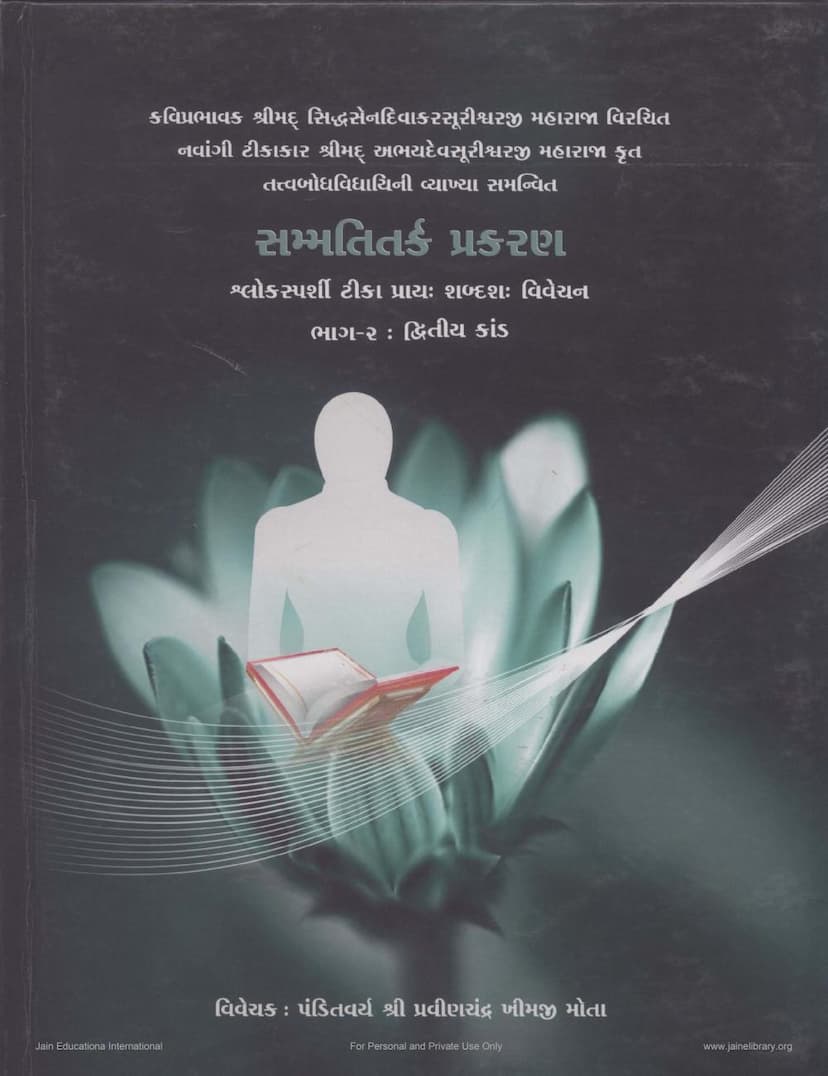Sammati Tark Prakaran Part 02
Added to library: September 2, 2025

Summary
Here's a comprehensive summary of the Jain text "Sammati Tark Prakaran Part 02" based on the provided pages:
Book Title: Sammati Tark Prakaran Part 02 (सम्</strong>मतितर्क प्रकरण भाग-२) Author: Pravinchandra Khimji Mota (पंडितवर्य श्री प्रवीणचंद्र खीमजी मोता) Original Author: Shrutsagar Shri Siddhasena Divakarsurishvarji Maharaj (श्रुतकेवली श्री सिद्धसेनदिवाकरसूरीश्वरजी महाराज) Commentary Author: Shrutsagar Shri Abhaydevsurishvarji Maharaj (नवांगी टीकाकार श्री अभयदेवसूरीश्वरजी महाराज) Publisher: Gitarth Ganga (गीतार्थ गंगा)
This summary focuses on the content of Part 02, which delves into the Second Chapter (द्व</strong>तीय<strong></strong>कांड) of the Sammati Tark Prakaran.
Overall Purpose and Context:
The text is a detailed commentary (श्</strong>लोक<strong></strong>स्पर्शी<strong></strong>टीका<strong></strong>प्रायः<strong></strong>शब्दशः<strong></strong>विवेक) on the original work by Shri Siddhasena Divakarsurishvarji Maharaj. Part 02, specifically the Second Chapter, aims to elaborate on the nature of perception (दर्शन - Darshana) and knowledge (ज्ञान - Jnana) within Jain philosophy, addressing various subtle philosophical points and refuting opposing viewpoints. The commentary by Shri Abhaydevsurishvarji Maharaj is being elucidated by Panditvarya Shri Pravinchandra Khimji Mota.
Key Themes and Arguments Presented in the Second Chapter:
The Second Chapter primarily focuses on the interplay and distinction between Darshana (perception, often considered the initial, general apprehension of an object) and Jnana (knowledge, the specific, detailed cognition of an object) within the framework of Jain logic and epistemology. It critically examines different philosophical positions, particularly regarding the nature of these faculties in both conditioned souls (छ</strong>द्मस्थ - Chhadmastha) and liberated souls (केव</strong>ली - Kevali).
Central Arguments and Discussions:
-
Darshana and Jnana as Distinct yet Interconnected: The chapter begins by establishing that while Darshana (perception) and Jnana (knowledge) are distinct in their functions (general vs. specific apprehension), they are often interconnected and co-dependent, especially in the case of conditioned beings. The analogy of "torch without knowing how to use it" highlights the inadequacy of having the scripture (Jain Shasan) without understanding its profound secrets.
-
Nayas (Perspectives) and their Application: The importance of applying different perspectives (Nayas) and classification (Nixhep) correctly to understand reality is emphasized, building upon the foundation laid in the First Chapter.
-
Nature of Perception (Darshana) and Knowledge (Jnana):
- Darshana: Described as the general apprehension of an object (सामान्य<strong></strong>ग्रहण - Samanya Grahan), it is characterized as "formless" (निराकार - Nirakar) or "unmanifest" (अ</strong>व्यक्त - Avyakta).
- Jnana: Described as the specific apprehension of an object (विशेष<strong></strong>ग्रहण - Vishesa Grahan), it is characterized as "form-bearing" (साकार - Sakara) or "manifest" (व्यक्त - Vyakt).
-
The Case of Kevalins (Liberated Souls): A significant portion of the chapter is dedicated to the state of Kevalins (omniscient and omniscient perceivers).
- Unified Consciousness: It argues that in the state of Kevalinhood, there is a single, unified consciousness (एक<strong></strong>पयोग - Ek<strong></strong>Upayoga) that encompasses both the general perception of substances (द्र</strong>व्य<strong></strong>- Dravya) and the specific cognition of modes (पर्याय<strong></strong>- Paryaya). This single consciousness is simultaneously knower and perceiver.
- Refutation of Sequential or Separate Faculties: The text refutes the notion that Kevalins experience Darshana and Jnana sequentially or as entirely separate faculties. It counters arguments based on certain scriptural interpretations that suggest a temporal separation or distinctness.
- The "Sada" (Always) and "Anekant" (Non-absolutism) of Kevalins: The omniscient state is described as "always" (</strong>सदा<strong></strong>- Sada) perceiving and knowing all aspects of reality without contradiction or error. The concept of "Anekanta" (non-absolutism) is crucial in understanding this unified yet multifaceted omniscience.
-
Analysis of Different Schools of Thought: The commentary engages with and refutes the views of various philosophical schools (e.g., those who believe in sequential knowledge, or those who believe in purely general or purely specific apprehension) to firmly establish the Jain perspective.
-
The Role of Consciousness (Upayoga): The nature of consciousness (Upayoga) is explored, emphasizing that it is the faculty that apprehends both general and specific aspects of reality. The text elaborates on how this consciousness operates in both conditioned and liberated states.
-
Detailed Examination of Knowledge Types: The chapter discusses:
- Mati-Shruta Jnana: The sequential nature of perception and knowledge in conditioned beings, with Mati-Jnana (sensory and mental knowledge) often involving an initial perception (Darshana) followed by specific knowledge (Jnana).
- Avadhi-Manaḥparyaya Jnana: These higher forms of knowledge are also analyzed in relation to perception, with the text aiming to clarify their unique characteristics and relationship with the faculties of perception.
- Keval-Jnana and Keval-Darshana: The core argument revolves around the unified nature of Kevala-Jnana (omniscient knowledge) and Kevala-Darshana (omniscient perception) in the liberated state, positing them as inseparable aspects of a single, all-encompassing consciousness.
-
Reinterpreting Scriptural Passages: The commentary meticulously analyzes scriptural passages, often cited by opposing views, to demonstrate how a correct understanding within the framework of Anekanta and Syadvada resolves apparent contradictions and supports the Jain perspective. For instance, it reinterprets passages that might seem to suggest a separation of knowing and seeing in Kevalins.
-
The Nature of Substance (Dravya) and Mode (Paryaya): The text continuously links the discussion of perception and knowledge back to the fundamental Jain concept of substance (Dravya) and its changing modes (Paryaya), highlighting how both are apprehended.
Structure and Methodology:
The commentary follows a rigorous dialectical approach, often presenting a point, raising a potential objection or opposing view, and then systematically refuting it with logical arguments, scriptural evidence, and nuanced philosophical distinctions. The verses (Gatha) are analyzed verse by verse, with the commentary (Tika) providing detailed explanations of the original verses and the author's (Pravinchandra Mota) own elucidations.
In essence, Part 02 of Sammati Tark Prakaran is a profound exploration of Jain epistemology, aiming to clarify the sophisticated understanding of perception and knowledge, particularly in the context of omniscience, by meticulously analyzing the interconnectedness and distinctions between these cognitive faculties, ultimately upholding the non-dualistic yet multifaceted nature of reality as presented by Jainism.